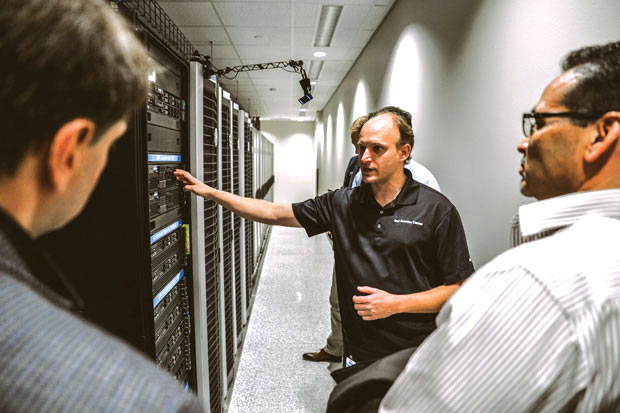HPC Handbook: Virtualization Gets Real

The Dell Workstation Virtualization Center of Excellence helps software providers and customers move high-end workloads into a virtualized workstation environment. Image courtesy of Dell.
Latest News
December 1, 2015
 The Dell Workstation Virtualization Center of Excellence helps software providers and customers move high-end workloads into a virtualized workstation environment. Image courtesy of Dell.
The Dell Workstation Virtualization Center of Excellence helps software providers and customers move high-end workloads into a virtualized workstation environment. Image courtesy of Dell.Editor’s Note: This is an excerpt of Chapter 4 from The Design Engineer’s High-Performance Computing Handbook. Download the complete version here.
The term virtualization refers to the practice of creating, maintaining, and deploying digital counterparts — or virtual versions — of hardware, operating systems, networking environments and storage systems. Constructed largely in software code, these virtual entities have one clear advantage over their physical siblings: They can be remotely accessed from anywhere. One type of virtualization that has been steadily gaining ground in the engineering community is desktop virtualization — duplicating the functions of powerful professional workstations in a virtual environment.
By and large, professional design and engineering workload demands workstation-class hardware. Such systems are configured with the right balance of processing power, graphics and memory to run industry-standard CAD, CAM and CAE software. They have also been tested and certified by independent software vendors (ISVs); therefore, they’re guaranteed to deliver optimal performance in the chosen software’s modeling, design and visualization environments. The drawback, however, is restricted mobility. Workstations — especially the desktop variety — are not designed to be easily portable. They’re designed to remain fixed in a designated location. Widespread connectivity has freed many types of workers from the offices and cubicles so they can work from home, from a cafe, on a train, at the airport—virtually anywhere they can find a reliable web connection. But this luxury eludes those in engineering who have computing needs that cannot be met with mobile workstations. Reliance on powerful desktop/deskside workstations means users must remain physically close to the hardware.However, in a virtualized environment, an engineer can work with a virtual machine, configured to deliver the same computing capacity of a physical workstation. The decoupling of the backend hardware from the frontend access point is one of the primary advantages of virtualization. In such a setup, an engineer can experience workstation-class performance remotely.
The other big benefit of desktop virtualization is realized by IT management. Because the virtual machines are all under the direct control of IT, it’s easier to apply updates, ensure security and quickly fix any issues that might arise. While some enigneers may balk at losing direct access to their physical machines, there are a number of enterprise-wide benefits that could tip the scales toward virtualization.
Driven by Server-Class Hardware
Contrary to what the name suggests, the virtual desktop infrastructure (VDI) is not exactly a hardware-free environment. Quite the opposite. The VDI has to be built on top-of-the-line server hardware, supported by a stack of robust virtualization software and reliable connectivity. Otherwise, the subpar experience of the virtual machine would be a compromise to the engineer who’s accustomed to a workstation’s responsiveness.
If you think hardware vendors might shun the virtualization movement, you’d be wrong. Despite their vested interest in workstation sales, Lenovo, Hitachi, Fujitsu, HP, Dell, Samsung and other major hardware providers are regular sponsors of the annual VMworld conference, an industry event dedicated to virtualization. In March 2014, Dell launched a new Workstation Virtualization Center of Excellence and Dell Wyse Datacenter for Virtual Workstations solution, two initiatives that anticipate the growth of VDI.
“We are seeing a change in the way users of data and graphics-intensive applications are able to securely access their data outside of the office,” said Andy Rhodes, executive director of Dell Precision product line. “The idea of the fixed location-based workstation has changed as users need to be mobile and collaborate efficiently with others both within and outside of their organization. Furthermore, the notion of a 1:1 relationship between a user and a piece of hardware is going away, as an increasing number of IT managers see desktop virtualization as a viable means of providing users with a secure, manageable and resource efficient way to access their desktops and applications.”
Every virtual machine in the private or public cloud is powered by a piece of physical hardware with enough computing resources to support it. VDI isn’t seen as the death knell for workstations. It could be the prelude to an era where you can access your workstation from any connected device.
Subscribe to our FREE magazine, FREE email newsletters or both!
Latest News
About the Author
DE’s editors contribute news and new product announcements to Digital Engineering.
Press releases may be sent to them via [email protected].






